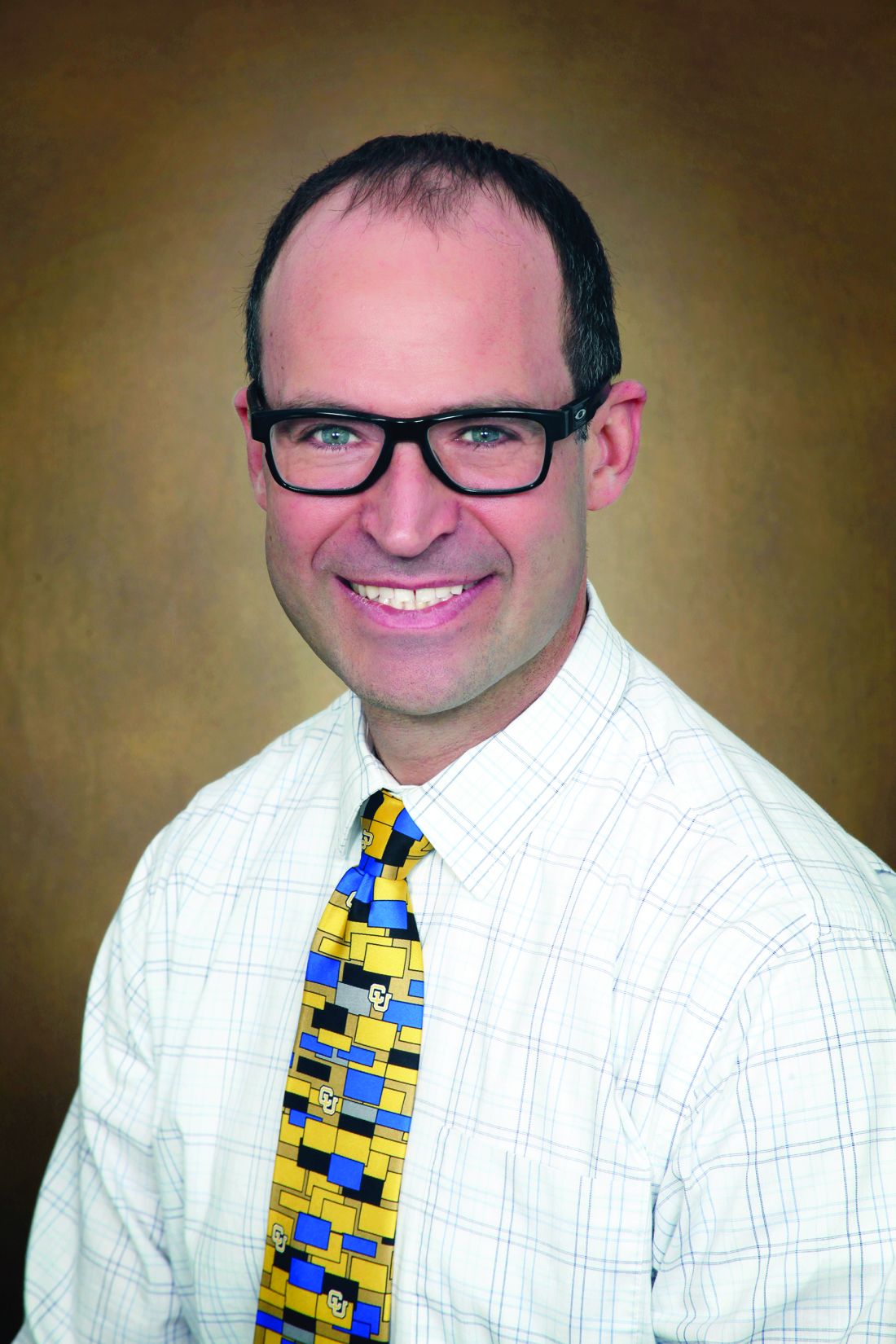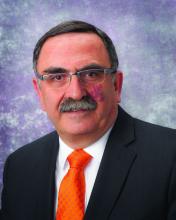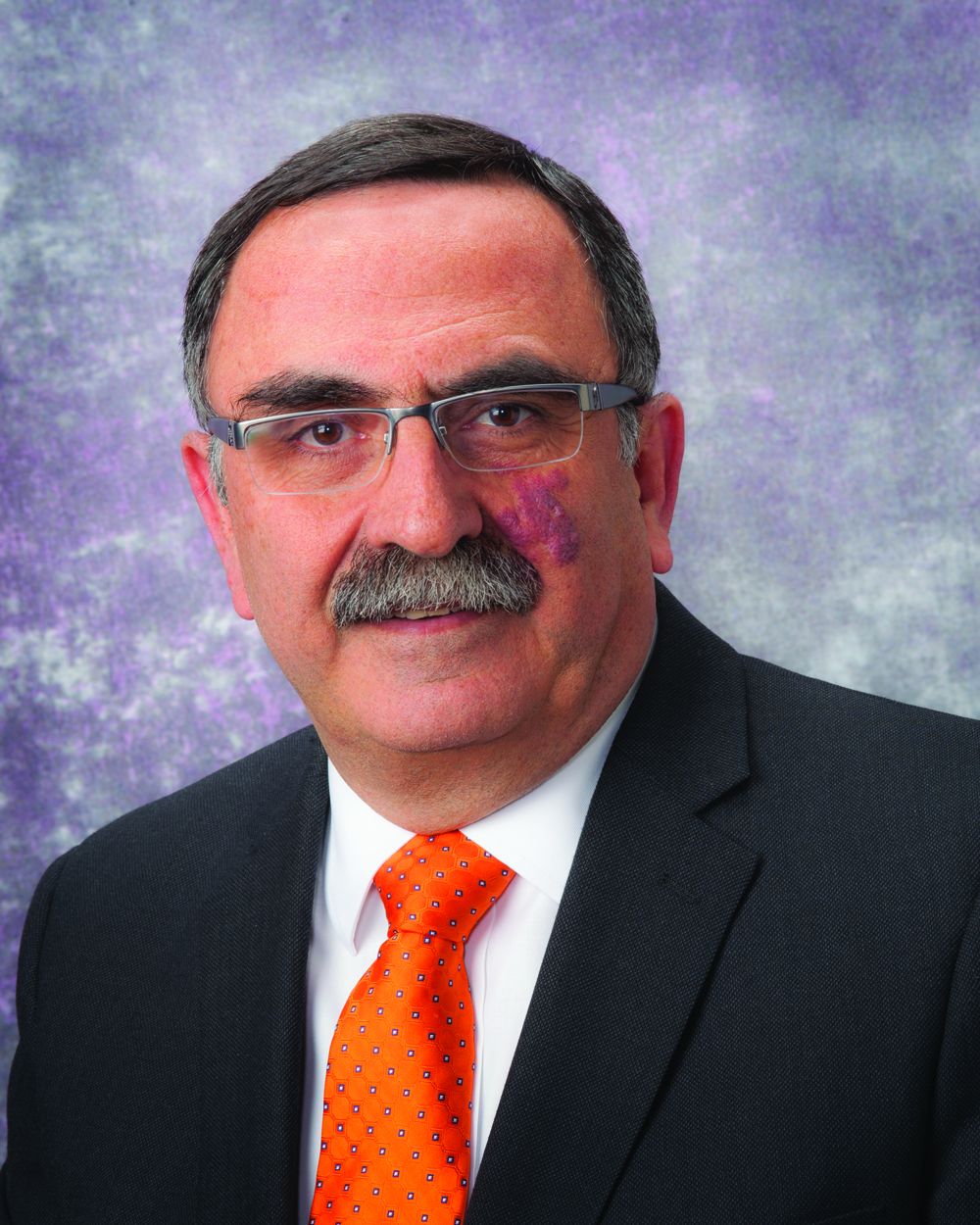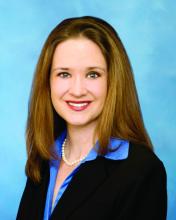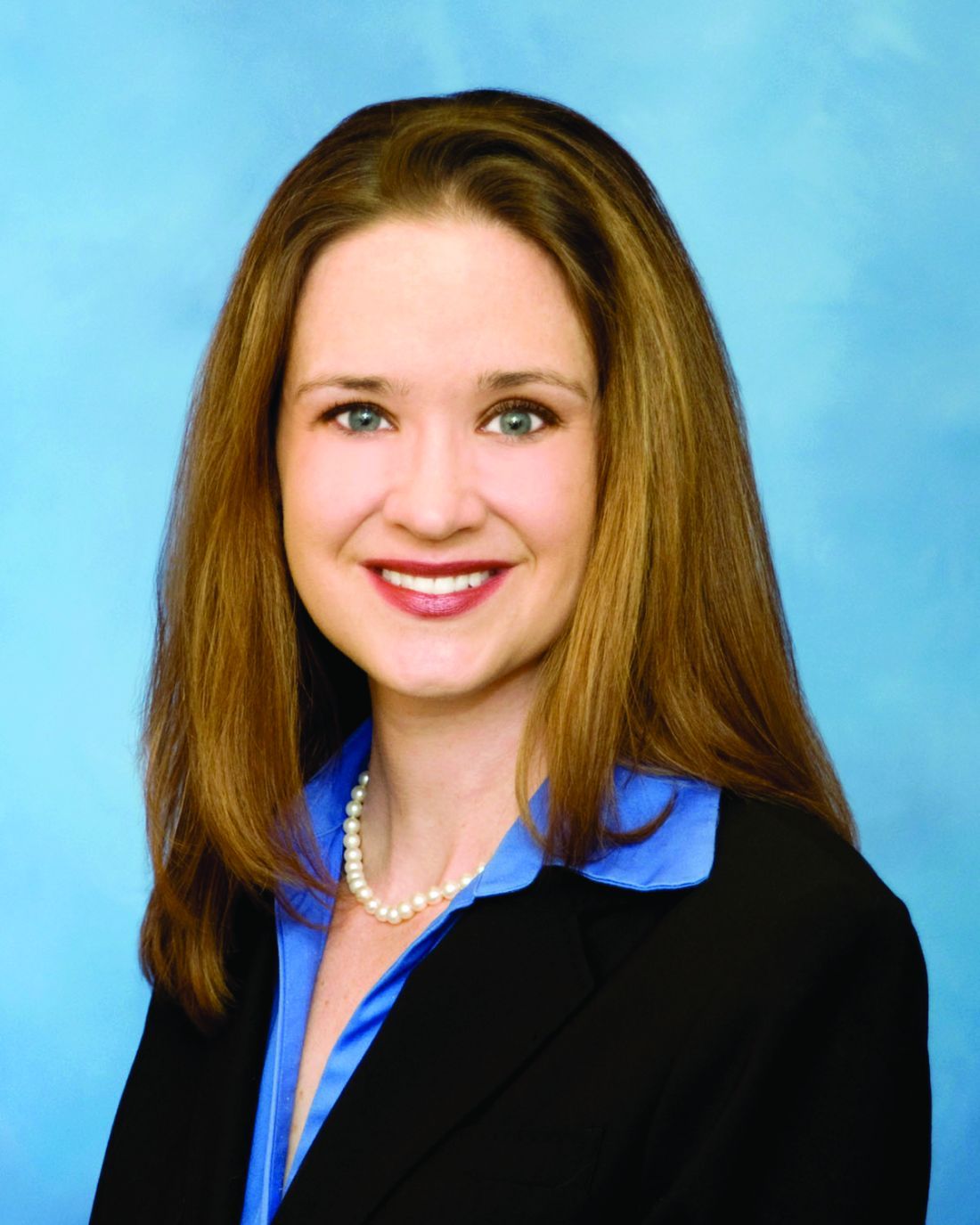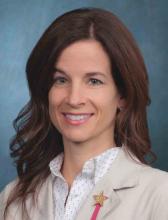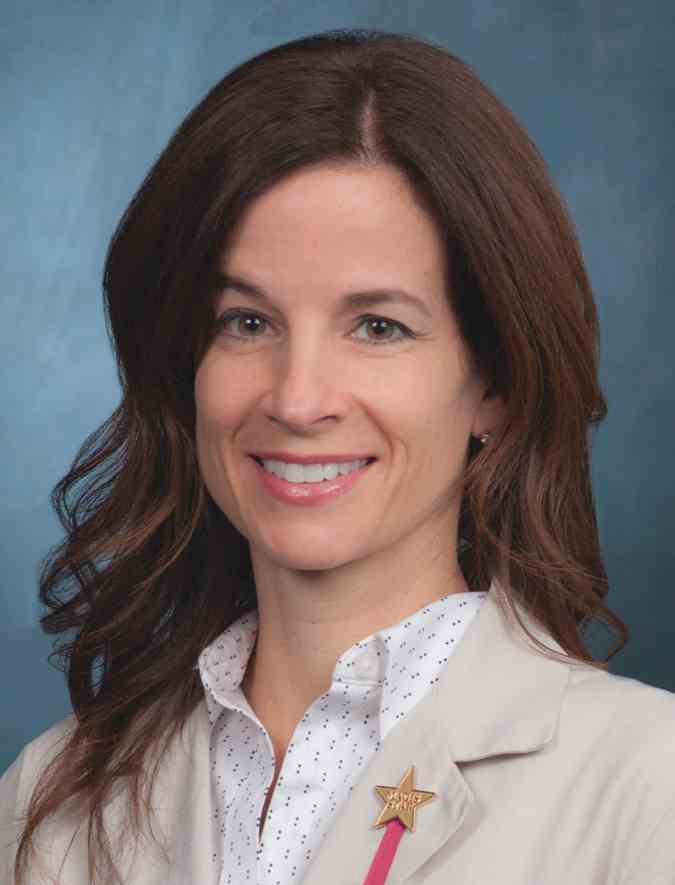User login
Everyone Can Participate in Gala Silent Auction
After months of planning, the day is finally here! Friday evening, 500 people will be living the high life at the “Vascular Spectacular” gala, celebrating the specialty and each other.
But everyone, no matter where they are in the world, may participate in the gala’s Silent Auction, right until it closes this evening.
In fact, bidding on nearly 70 items began in late May. Here’s how to join in the fun:
• Sign up on vam19gala.givesmart.com and peruse the selections.
• Place a bid. All bidders will be identified by name.
• If desired, monitor the bidding, by setting up notifications to learn when someone else ups the ante.
• Continue to bid until the auction closes during the gala itself.
• Wait for your prizes to be mailed to you — and know you have contributed to continuing the important work of the SVS Foundation.
The live auction takes place at the gala in its entirety and only those present can bid.
The Gala Committee is comprised of Drs. Cynthia Shortell and Benjamin Starnes, cochairs; and Enrico Ascher, William Jordan Jr., Melina Kibbe, Richard Lynn, Matthew Mell, Ben Pearce, Amy Reed, Russell Samson, William Shutze, Mal Sheahan, Maureen Sheehan and Anton Sidawy.
What’s available? Dr. Clem Darling’s “Darling Magical Whiskery Tour” to sample top-tier whiskey in the mutually agreed-upon city; a stay in Lake Tahoe, a beach-front condo in Florida and a spacious townhome at the entrance to Rehoboth Beach, Del.; wildlife photos; fine art; jewelry; fine wine; portraits for people and pets; sports-related items; Maui Jim sunglasses; free admission to attractions from coast to coast and more. There are even one-on-one sessions with a number of vascular surgeons.
In addition, Cydar Medical is offering a one-year subscription to Cydar EV Fusion Imaging, the world’s first AI-powered image fusion platform, valued at $50,000.
All proceeds benefit the SVS Foundation.
After months of planning, the day is finally here! Friday evening, 500 people will be living the high life at the “Vascular Spectacular” gala, celebrating the specialty and each other.
But everyone, no matter where they are in the world, may participate in the gala’s Silent Auction, right until it closes this evening.
In fact, bidding on nearly 70 items began in late May. Here’s how to join in the fun:
• Sign up on vam19gala.givesmart.com and peruse the selections.
• Place a bid. All bidders will be identified by name.
• If desired, monitor the bidding, by setting up notifications to learn when someone else ups the ante.
• Continue to bid until the auction closes during the gala itself.
• Wait for your prizes to be mailed to you — and know you have contributed to continuing the important work of the SVS Foundation.
The live auction takes place at the gala in its entirety and only those present can bid.
The Gala Committee is comprised of Drs. Cynthia Shortell and Benjamin Starnes, cochairs; and Enrico Ascher, William Jordan Jr., Melina Kibbe, Richard Lynn, Matthew Mell, Ben Pearce, Amy Reed, Russell Samson, William Shutze, Mal Sheahan, Maureen Sheehan and Anton Sidawy.
What’s available? Dr. Clem Darling’s “Darling Magical Whiskery Tour” to sample top-tier whiskey in the mutually agreed-upon city; a stay in Lake Tahoe, a beach-front condo in Florida and a spacious townhome at the entrance to Rehoboth Beach, Del.; wildlife photos; fine art; jewelry; fine wine; portraits for people and pets; sports-related items; Maui Jim sunglasses; free admission to attractions from coast to coast and more. There are even one-on-one sessions with a number of vascular surgeons.
In addition, Cydar Medical is offering a one-year subscription to Cydar EV Fusion Imaging, the world’s first AI-powered image fusion platform, valued at $50,000.
All proceeds benefit the SVS Foundation.
After months of planning, the day is finally here! Friday evening, 500 people will be living the high life at the “Vascular Spectacular” gala, celebrating the specialty and each other.
But everyone, no matter where they are in the world, may participate in the gala’s Silent Auction, right until it closes this evening.
In fact, bidding on nearly 70 items began in late May. Here’s how to join in the fun:
• Sign up on vam19gala.givesmart.com and peruse the selections.
• Place a bid. All bidders will be identified by name.
• If desired, monitor the bidding, by setting up notifications to learn when someone else ups the ante.
• Continue to bid until the auction closes during the gala itself.
• Wait for your prizes to be mailed to you — and know you have contributed to continuing the important work of the SVS Foundation.
The live auction takes place at the gala in its entirety and only those present can bid.
The Gala Committee is comprised of Drs. Cynthia Shortell and Benjamin Starnes, cochairs; and Enrico Ascher, William Jordan Jr., Melina Kibbe, Richard Lynn, Matthew Mell, Ben Pearce, Amy Reed, Russell Samson, William Shutze, Mal Sheahan, Maureen Sheehan and Anton Sidawy.
What’s available? Dr. Clem Darling’s “Darling Magical Whiskery Tour” to sample top-tier whiskey in the mutually agreed-upon city; a stay in Lake Tahoe, a beach-front condo in Florida and a spacious townhome at the entrance to Rehoboth Beach, Del.; wildlife photos; fine art; jewelry; fine wine; portraits for people and pets; sports-related items; Maui Jim sunglasses; free admission to attractions from coast to coast and more. There are even one-on-one sessions with a number of vascular surgeons.
In addition, Cydar Medical is offering a one-year subscription to Cydar EV Fusion Imaging, the world’s first AI-powered image fusion platform, valued at $50,000.
All proceeds benefit the SVS Foundation.
Learn About Starting a Vascular Training Program
Starting a vascular surgery integrated program or fellowship can be a daunting process. There exist a number of misconceptions about required case volume, program affiliations, and required number of faculty.
Requirements for creating such programs have recently been lightened. And the SVS and the Association of Program Directors in Vascular Surgery have a number of initiatives in place to help.
SVS will host an informational session for anyone interested in starting a program from 9:30 to 10:30 a.m. Friday, June 14, in National Harbor 4. Most of the session will be interactive, with experienced program directors offering participants useful information and practical advice.
Starting a vascular surgery integrated program or fellowship can be a daunting process. There exist a number of misconceptions about required case volume, program affiliations, and required number of faculty.
Requirements for creating such programs have recently been lightened. And the SVS and the Association of Program Directors in Vascular Surgery have a number of initiatives in place to help.
SVS will host an informational session for anyone interested in starting a program from 9:30 to 10:30 a.m. Friday, June 14, in National Harbor 4. Most of the session will be interactive, with experienced program directors offering participants useful information and practical advice.
Starting a vascular surgery integrated program or fellowship can be a daunting process. There exist a number of misconceptions about required case volume, program affiliations, and required number of faculty.
Requirements for creating such programs have recently been lightened. And the SVS and the Association of Program Directors in Vascular Surgery have a number of initiatives in place to help.
SVS will host an informational session for anyone interested in starting a program from 9:30 to 10:30 a.m. Friday, June 14, in National Harbor 4. Most of the session will be interactive, with experienced program directors offering participants useful information and practical advice.
National Survey Examines the Extent, Effects of Pain in Vascular Surgeons
Work-related pain and disability have been reported in the literature among various surgical specialties and can influence surgeon productivity and burnout. In Friday’s Scientific Session 4, Max Wohlauer, MD, of the University of Colorado, Denver, will report on a study that he and his colleagues performed to identify the prevalence and severity of pain symptoms in vascular surgeons.
Dr. Wohlauer will report on their survey, which was emailed to 2,910 members of the Society for Vascular Surgery. Pain was reported using the 0–10 Borg’s CR-10 scale, with 0 = no pain, 3 = moderate, 4 = somewhat strong, 5 = strong, and 10 = maximum pain.
Dr. Wohlauer and his colleagues received responses from 775 (26.6%) of the vascular surgeons; with retirees excluded from the study. Among those actively working, the mean age was 51.4 years, and the surgeons had a mean of 17.2 years in practice; 83.6% of the respondents were men.
According to the survey, after a full day of open surgery, the majority of vascular surgeons reported being in a somewhat strong amount of pain (mean score 4.4), while after a full day of endovascular procedures, most vascular surgeons reported being in a moderate amount of pain (mean score 3.9).
Pain following a day of open surgery was highest in the neck (45%) and lower back (39%);after endovascular procedures, respondents reported pain to be most severe in the lower back (44%) and neck (24%). Surgeons performing endovenous procedures report the lowest pain scores (mean 2.0).
In terms of treatment, 242 (36.9%) vascular surgeons reported having sought medical care for work-related issues, with 61 (8.3%) taking time away from the operating room. A total of 72 surgeons (10%) reported requiring surgery and other procedures (including traction), and 22 (3%) had been placed on short- or long-term disability.
In total, 193 (26.2%) of surgeons report pain severe enough that it interfered with sleep, with 9 (1.2%) leaving their career because of disability from work-related pain, and high work-related physical discomfort was significantly associated with Maslach Burnout Inventory single-item measure of burnout for open surgery, endovascular, and endovenous procedures, according to Dr. Wohlauer.
Altogether, 334 (50.6%) of the vascular surgeons surveyed reported that physical discomfort will affect the longevity of their career. This is borne out by the fact that, of the 39 respondents no longer practicing surgery, 26% (10) retired because of disability from work-related pain.
“Our study shows that the majority of practicing vascular surgeons are in pain after a day of operating. Work-related disability is significantly diminishing the workforce. Addressing work-related pain serves to improve the lives and careers of vascular surgeons, while enhancing surgical longevity would help address the current national workforce shortage,” Dr. Wohlauer concluded.
Friday
8-9:30 a.m.
Gaylor National, Potomac A/B
S4: Scientific Session 4: SS12
Work-related pain and disability have been reported in the literature among various surgical specialties and can influence surgeon productivity and burnout. In Friday’s Scientific Session 4, Max Wohlauer, MD, of the University of Colorado, Denver, will report on a study that he and his colleagues performed to identify the prevalence and severity of pain symptoms in vascular surgeons.
Dr. Wohlauer will report on their survey, which was emailed to 2,910 members of the Society for Vascular Surgery. Pain was reported using the 0–10 Borg’s CR-10 scale, with 0 = no pain, 3 = moderate, 4 = somewhat strong, 5 = strong, and 10 = maximum pain.
Dr. Wohlauer and his colleagues received responses from 775 (26.6%) of the vascular surgeons; with retirees excluded from the study. Among those actively working, the mean age was 51.4 years, and the surgeons had a mean of 17.2 years in practice; 83.6% of the respondents were men.
According to the survey, after a full day of open surgery, the majority of vascular surgeons reported being in a somewhat strong amount of pain (mean score 4.4), while after a full day of endovascular procedures, most vascular surgeons reported being in a moderate amount of pain (mean score 3.9).
Pain following a day of open surgery was highest in the neck (45%) and lower back (39%);after endovascular procedures, respondents reported pain to be most severe in the lower back (44%) and neck (24%). Surgeons performing endovenous procedures report the lowest pain scores (mean 2.0).
In terms of treatment, 242 (36.9%) vascular surgeons reported having sought medical care for work-related issues, with 61 (8.3%) taking time away from the operating room. A total of 72 surgeons (10%) reported requiring surgery and other procedures (including traction), and 22 (3%) had been placed on short- or long-term disability.
In total, 193 (26.2%) of surgeons report pain severe enough that it interfered with sleep, with 9 (1.2%) leaving their career because of disability from work-related pain, and high work-related physical discomfort was significantly associated with Maslach Burnout Inventory single-item measure of burnout for open surgery, endovascular, and endovenous procedures, according to Dr. Wohlauer.
Altogether, 334 (50.6%) of the vascular surgeons surveyed reported that physical discomfort will affect the longevity of their career. This is borne out by the fact that, of the 39 respondents no longer practicing surgery, 26% (10) retired because of disability from work-related pain.
“Our study shows that the majority of practicing vascular surgeons are in pain after a day of operating. Work-related disability is significantly diminishing the workforce. Addressing work-related pain serves to improve the lives and careers of vascular surgeons, while enhancing surgical longevity would help address the current national workforce shortage,” Dr. Wohlauer concluded.
Friday
8-9:30 a.m.
Gaylor National, Potomac A/B
S4: Scientific Session 4: SS12
Work-related pain and disability have been reported in the literature among various surgical specialties and can influence surgeon productivity and burnout. In Friday’s Scientific Session 4, Max Wohlauer, MD, of the University of Colorado, Denver, will report on a study that he and his colleagues performed to identify the prevalence and severity of pain symptoms in vascular surgeons.
Dr. Wohlauer will report on their survey, which was emailed to 2,910 members of the Society for Vascular Surgery. Pain was reported using the 0–10 Borg’s CR-10 scale, with 0 = no pain, 3 = moderate, 4 = somewhat strong, 5 = strong, and 10 = maximum pain.
Dr. Wohlauer and his colleagues received responses from 775 (26.6%) of the vascular surgeons; with retirees excluded from the study. Among those actively working, the mean age was 51.4 years, and the surgeons had a mean of 17.2 years in practice; 83.6% of the respondents were men.
According to the survey, after a full day of open surgery, the majority of vascular surgeons reported being in a somewhat strong amount of pain (mean score 4.4), while after a full day of endovascular procedures, most vascular surgeons reported being in a moderate amount of pain (mean score 3.9).
Pain following a day of open surgery was highest in the neck (45%) and lower back (39%);after endovascular procedures, respondents reported pain to be most severe in the lower back (44%) and neck (24%). Surgeons performing endovenous procedures report the lowest pain scores (mean 2.0).
In terms of treatment, 242 (36.9%) vascular surgeons reported having sought medical care for work-related issues, with 61 (8.3%) taking time away from the operating room. A total of 72 surgeons (10%) reported requiring surgery and other procedures (including traction), and 22 (3%) had been placed on short- or long-term disability.
In total, 193 (26.2%) of surgeons report pain severe enough that it interfered with sleep, with 9 (1.2%) leaving their career because of disability from work-related pain, and high work-related physical discomfort was significantly associated with Maslach Burnout Inventory single-item measure of burnout for open surgery, endovascular, and endovenous procedures, according to Dr. Wohlauer.
Altogether, 334 (50.6%) of the vascular surgeons surveyed reported that physical discomfort will affect the longevity of their career. This is borne out by the fact that, of the 39 respondents no longer practicing surgery, 26% (10) retired because of disability from work-related pain.
“Our study shows that the majority of practicing vascular surgeons are in pain after a day of operating. Work-related disability is significantly diminishing the workforce. Addressing work-related pain serves to improve the lives and careers of vascular surgeons, while enhancing surgical longevity would help address the current national workforce shortage,” Dr. Wohlauer concluded.
Friday
8-9:30 a.m.
Gaylor National, Potomac A/B
S4: Scientific Session 4: SS12
From Our President
Society for Vascular Surgery President Michel S. Makaroun, MD, will reflect on his presidency during the 2019 Presidential Address, on Friday, June 14, from 11:15 a.m. to 12:15 p.m. President-Elect Kim Hodgson, MD, will introduce Dr. Makaroun, beginning at 11 a.m.
Dr. Makaroun is professor of surgery and clinical translational science at the University of Pittsburgh. He is the chair of vascular surgery and codirector of the University of Pittsburgh Medical Center Heart and Vascular Institute.
His address, “I am in Favor of Progress ... It is Change I Do Not Like,” will take place in Ballroom A/B.
Society for Vascular Surgery President Michel S. Makaroun, MD, will reflect on his presidency during the 2019 Presidential Address, on Friday, June 14, from 11:15 a.m. to 12:15 p.m. President-Elect Kim Hodgson, MD, will introduce Dr. Makaroun, beginning at 11 a.m.
Dr. Makaroun is professor of surgery and clinical translational science at the University of Pittsburgh. He is the chair of vascular surgery and codirector of the University of Pittsburgh Medical Center Heart and Vascular Institute.
His address, “I am in Favor of Progress ... It is Change I Do Not Like,” will take place in Ballroom A/B.
Society for Vascular Surgery President Michel S. Makaroun, MD, will reflect on his presidency during the 2019 Presidential Address, on Friday, June 14, from 11:15 a.m. to 12:15 p.m. President-Elect Kim Hodgson, MD, will introduce Dr. Makaroun, beginning at 11 a.m.
Dr. Makaroun is professor of surgery and clinical translational science at the University of Pittsburgh. He is the chair of vascular surgery and codirector of the University of Pittsburgh Medical Center Heart and Vascular Institute.
His address, “I am in Favor of Progress ... It is Change I Do Not Like,” will take place in Ballroom A/B.
Burnout Among Vascular Surgeons – A Report From the SVS Wellness Committee
Physician burnout has been linked to medical errors, decreased patient satisfaction, and reduced career longevity. In light of the increasing prevalence of cardiovascular disease, vascular surgeon burnout presents a legitimate public health concern because of the impact on the adequacy of the vascular surgery workforce. Dawn Coleman, MD, and her colleagues, performed a study on behalf of the Society for Vascular Surgery (SVS) Wellness Task Force to define the prevalence of burnout among practicing vascular surgeons, and to identify the risk factors for burnout. Such information will be used to facilitate future SVS initiatives to avert this crisis.
In Thursday’s von Liebig Forum, Dr. Coleman, of the University of Michigan, Ann Arbor, will present the results of their 2018 anonymous survey of active SVS members. The survey used a validated burnout assessment, Maslach Burnout Index (MBI), embedded in a questionnaire that also captured demographic and practice-related characteristics.
The survey was personalized for the specialty and did allow for free text. according to Dr. Coleman, and “we specifically analyzed emotional exhaustion, one dimension of burnout.”
The accepted threshold of a score of 27 or greater on the MBI Emotional Exhaustion module was used to identify surgeons suffering from burnout. Risk factors for such were identified using bivariate analyses (Chi-square, Kruskal-Wallis), and multivariate logistic regression models were developed to identify independent risk factors for burnout, she added.
Dr. Coleman will present the results from the 960 out of 2,905 active SVS members who responded to the survey (33%). After excluding retired surgeons and incomplete submissions, responses from 872 practicing vascular surgeons were finally analyzed. The mean respondent age was 49.7 years; and the majority of respondents (81%) were men. The primary practice settings were academic (40%), community practice (41%), Veterans Administration hospital (3.3%), active military practice (1.5%), or “other.” Mean years in practice was 15.7.
Overall, 30% of the respondents met criteria for burnout, 37% screened positive for symptoms of depression in the past month and 8% supported thoughts of taking their own life during the last 12 months.
By unadjusted analysis, factors significantly associated with burnout included clinical work hours, on-call frequency, electronic medical record/documentation requirements, perceived conflict between work and personal responsibilities, and physical pain. Multivariate analysis revealed age, work-related physical pain, and conflict between work and personal responsibilities as independent risk factors for burnout, said Dr. Coleman.
“Approximately one-third of practicing vascular surgeons self-report burnout and depression, according to our survey. Advancing age, physical pain, and work-life conflict are each independent predictors for burnout among vascular surgeons. These findings will facilitate SVS efforts to improve vascular surgeon well-being, in an effort to mitigate the personal, economic, and social impact of vascular surgeon burnout,” Dr. Coleman concluded.
See more on the work of the SVS Wellness Task Force in the June issue of Vascular Specialist.
Physician burnout has been linked to medical errors, decreased patient satisfaction, and reduced career longevity. In light of the increasing prevalence of cardiovascular disease, vascular surgeon burnout presents a legitimate public health concern because of the impact on the adequacy of the vascular surgery workforce. Dawn Coleman, MD, and her colleagues, performed a study on behalf of the Society for Vascular Surgery (SVS) Wellness Task Force to define the prevalence of burnout among practicing vascular surgeons, and to identify the risk factors for burnout. Such information will be used to facilitate future SVS initiatives to avert this crisis.
In Thursday’s von Liebig Forum, Dr. Coleman, of the University of Michigan, Ann Arbor, will present the results of their 2018 anonymous survey of active SVS members. The survey used a validated burnout assessment, Maslach Burnout Index (MBI), embedded in a questionnaire that also captured demographic and practice-related characteristics.
The survey was personalized for the specialty and did allow for free text. according to Dr. Coleman, and “we specifically analyzed emotional exhaustion, one dimension of burnout.”
The accepted threshold of a score of 27 or greater on the MBI Emotional Exhaustion module was used to identify surgeons suffering from burnout. Risk factors for such were identified using bivariate analyses (Chi-square, Kruskal-Wallis), and multivariate logistic regression models were developed to identify independent risk factors for burnout, she added.
Dr. Coleman will present the results from the 960 out of 2,905 active SVS members who responded to the survey (33%). After excluding retired surgeons and incomplete submissions, responses from 872 practicing vascular surgeons were finally analyzed. The mean respondent age was 49.7 years; and the majority of respondents (81%) were men. The primary practice settings were academic (40%), community practice (41%), Veterans Administration hospital (3.3%), active military practice (1.5%), or “other.” Mean years in practice was 15.7.
Overall, 30% of the respondents met criteria for burnout, 37% screened positive for symptoms of depression in the past month and 8% supported thoughts of taking their own life during the last 12 months.
By unadjusted analysis, factors significantly associated with burnout included clinical work hours, on-call frequency, electronic medical record/documentation requirements, perceived conflict between work and personal responsibilities, and physical pain. Multivariate analysis revealed age, work-related physical pain, and conflict between work and personal responsibilities as independent risk factors for burnout, said Dr. Coleman.
“Approximately one-third of practicing vascular surgeons self-report burnout and depression, according to our survey. Advancing age, physical pain, and work-life conflict are each independent predictors for burnout among vascular surgeons. These findings will facilitate SVS efforts to improve vascular surgeon well-being, in an effort to mitigate the personal, economic, and social impact of vascular surgeon burnout,” Dr. Coleman concluded.
See more on the work of the SVS Wellness Task Force in the June issue of Vascular Specialist.
Physician burnout has been linked to medical errors, decreased patient satisfaction, and reduced career longevity. In light of the increasing prevalence of cardiovascular disease, vascular surgeon burnout presents a legitimate public health concern because of the impact on the adequacy of the vascular surgery workforce. Dawn Coleman, MD, and her colleagues, performed a study on behalf of the Society for Vascular Surgery (SVS) Wellness Task Force to define the prevalence of burnout among practicing vascular surgeons, and to identify the risk factors for burnout. Such information will be used to facilitate future SVS initiatives to avert this crisis.
In Thursday’s von Liebig Forum, Dr. Coleman, of the University of Michigan, Ann Arbor, will present the results of their 2018 anonymous survey of active SVS members. The survey used a validated burnout assessment, Maslach Burnout Index (MBI), embedded in a questionnaire that also captured demographic and practice-related characteristics.
The survey was personalized for the specialty and did allow for free text. according to Dr. Coleman, and “we specifically analyzed emotional exhaustion, one dimension of burnout.”
The accepted threshold of a score of 27 or greater on the MBI Emotional Exhaustion module was used to identify surgeons suffering from burnout. Risk factors for such were identified using bivariate analyses (Chi-square, Kruskal-Wallis), and multivariate logistic regression models were developed to identify independent risk factors for burnout, she added.
Dr. Coleman will present the results from the 960 out of 2,905 active SVS members who responded to the survey (33%). After excluding retired surgeons and incomplete submissions, responses from 872 practicing vascular surgeons were finally analyzed. The mean respondent age was 49.7 years; and the majority of respondents (81%) were men. The primary practice settings were academic (40%), community practice (41%), Veterans Administration hospital (3.3%), active military practice (1.5%), or “other.” Mean years in practice was 15.7.
Overall, 30% of the respondents met criteria for burnout, 37% screened positive for symptoms of depression in the past month and 8% supported thoughts of taking their own life during the last 12 months.
By unadjusted analysis, factors significantly associated with burnout included clinical work hours, on-call frequency, electronic medical record/documentation requirements, perceived conflict between work and personal responsibilities, and physical pain. Multivariate analysis revealed age, work-related physical pain, and conflict between work and personal responsibilities as independent risk factors for burnout, said Dr. Coleman.
“Approximately one-third of practicing vascular surgeons self-report burnout and depression, according to our survey. Advancing age, physical pain, and work-life conflict are each independent predictors for burnout among vascular surgeons. These findings will facilitate SVS efforts to improve vascular surgeon well-being, in an effort to mitigate the personal, economic, and social impact of vascular surgeon burnout,” Dr. Coleman concluded.
See more on the work of the SVS Wellness Task Force in the June issue of Vascular Specialist.
Gender Disparity and Sexual Harassment in Vascular Surgery Practices
Sexual harassment is known to be more pervasive in male-dominated workplaces and flourishes in a climate of tolerance and culture of silence, according to Bernadette Aulivola, MD, of Loyola University Medical Center, Maywood, Ill.
“We sought to examine the prevalence of sexual harassment in academic vascular surgery practices, identify factors associated with occurrence, determine reporting barriers, and identify any gender bias that exists,” said Dr. Aulivola.
In Wednesday’s VESS session, Dr. Aulivola will present the results of an anonymous survey that she and Matthew R. Smeds, MD, of Saint Louis University, conducted to examine the issue. The survey was emailed to 346 vascular surgery faculty members at 52 training sites in the United States.
“This research stemmed from a similar project done in vascular surgery trainees (residents and trainees) that identified a significant amount of harassment occurring at this level with a concomitant fear of reporting and lack of knowledge of institutional reporting mechanisms. We thought an analysis of harassment at the attending physician level may be relevant. There is significant gender bias in medicine in general and a not insignificant rate of harassment that occurs,” Dr. Smeds said in an interview.
Of the invitations sent, 149 (43%) completed the survey. Among these, 48/149 (32%) thought harassment occurred more commonly in surgical specialties with historical male dominance. In addition, ignoring the behavior, and hierarchy/power dynamics were the most common reasons given for its occurrence. Overall, 61/149 (41%) reported experiencing workplace harassment. Being told unwanted sexually explicit comments/questions/jokes, being called a sexist slur/nickname, or being paid unwanted flirtation were the most commonly described behaviors.
Those harassed were significantly more likely to be female (37% vs. 13%), and on average had experienced 2.6 (of 10) types of harassment. Despite 84% of respondents acknowledging institutional reporting mechanisms, only 7.2% of the harassing behaviors were reported.
The most common reasons for not reporting including feeling the behavior was “harmless” (67%) or “nothing positive would come of it” (28%), although 30% of respondents feared repercussions or felt uncomfortable identifying as a target of sexual harassment and only 59% of respondents reported that they would feel comfortable discussing the issue with departmental/divisional leadership.
“A significant number of vascular surgeons in academic practice have experienced workplace sexual harassment,” Dr. Aulivola said. “While most are aware of institutional reporting mechanisms, very few events are reported and less than 60% of respondents feel comfortable reporting to departmental/divisional leadership. Female vascular surgeons believe gender influences hiring, promotion, compensation, and attainment of life goals. Further work is necessary to identify methods of reducing workplace sexual harassment and optimize gender disparity in academic vascular surgery practice,” she concluded.
Wednesday, June 12
12:30-4:15 p.m.
Gaylord National, Maryland D
V2: VESS Paper Session 2: VESS18
Sexual harassment is known to be more pervasive in male-dominated workplaces and flourishes in a climate of tolerance and culture of silence, according to Bernadette Aulivola, MD, of Loyola University Medical Center, Maywood, Ill.
“We sought to examine the prevalence of sexual harassment in academic vascular surgery practices, identify factors associated with occurrence, determine reporting barriers, and identify any gender bias that exists,” said Dr. Aulivola.
In Wednesday’s VESS session, Dr. Aulivola will present the results of an anonymous survey that she and Matthew R. Smeds, MD, of Saint Louis University, conducted to examine the issue. The survey was emailed to 346 vascular surgery faculty members at 52 training sites in the United States.
“This research stemmed from a similar project done in vascular surgery trainees (residents and trainees) that identified a significant amount of harassment occurring at this level with a concomitant fear of reporting and lack of knowledge of institutional reporting mechanisms. We thought an analysis of harassment at the attending physician level may be relevant. There is significant gender bias in medicine in general and a not insignificant rate of harassment that occurs,” Dr. Smeds said in an interview.
Of the invitations sent, 149 (43%) completed the survey. Among these, 48/149 (32%) thought harassment occurred more commonly in surgical specialties with historical male dominance. In addition, ignoring the behavior, and hierarchy/power dynamics were the most common reasons given for its occurrence. Overall, 61/149 (41%) reported experiencing workplace harassment. Being told unwanted sexually explicit comments/questions/jokes, being called a sexist slur/nickname, or being paid unwanted flirtation were the most commonly described behaviors.
Those harassed were significantly more likely to be female (37% vs. 13%), and on average had experienced 2.6 (of 10) types of harassment. Despite 84% of respondents acknowledging institutional reporting mechanisms, only 7.2% of the harassing behaviors were reported.
The most common reasons for not reporting including feeling the behavior was “harmless” (67%) or “nothing positive would come of it” (28%), although 30% of respondents feared repercussions or felt uncomfortable identifying as a target of sexual harassment and only 59% of respondents reported that they would feel comfortable discussing the issue with departmental/divisional leadership.
“A significant number of vascular surgeons in academic practice have experienced workplace sexual harassment,” Dr. Aulivola said. “While most are aware of institutional reporting mechanisms, very few events are reported and less than 60% of respondents feel comfortable reporting to departmental/divisional leadership. Female vascular surgeons believe gender influences hiring, promotion, compensation, and attainment of life goals. Further work is necessary to identify methods of reducing workplace sexual harassment and optimize gender disparity in academic vascular surgery practice,” she concluded.
Wednesday, June 12
12:30-4:15 p.m.
Gaylord National, Maryland D
V2: VESS Paper Session 2: VESS18
Sexual harassment is known to be more pervasive in male-dominated workplaces and flourishes in a climate of tolerance and culture of silence, according to Bernadette Aulivola, MD, of Loyola University Medical Center, Maywood, Ill.
“We sought to examine the prevalence of sexual harassment in academic vascular surgery practices, identify factors associated with occurrence, determine reporting barriers, and identify any gender bias that exists,” said Dr. Aulivola.
In Wednesday’s VESS session, Dr. Aulivola will present the results of an anonymous survey that she and Matthew R. Smeds, MD, of Saint Louis University, conducted to examine the issue. The survey was emailed to 346 vascular surgery faculty members at 52 training sites in the United States.
“This research stemmed from a similar project done in vascular surgery trainees (residents and trainees) that identified a significant amount of harassment occurring at this level with a concomitant fear of reporting and lack of knowledge of institutional reporting mechanisms. We thought an analysis of harassment at the attending physician level may be relevant. There is significant gender bias in medicine in general and a not insignificant rate of harassment that occurs,” Dr. Smeds said in an interview.
Of the invitations sent, 149 (43%) completed the survey. Among these, 48/149 (32%) thought harassment occurred more commonly in surgical specialties with historical male dominance. In addition, ignoring the behavior, and hierarchy/power dynamics were the most common reasons given for its occurrence. Overall, 61/149 (41%) reported experiencing workplace harassment. Being told unwanted sexually explicit comments/questions/jokes, being called a sexist slur/nickname, or being paid unwanted flirtation were the most commonly described behaviors.
Those harassed were significantly more likely to be female (37% vs. 13%), and on average had experienced 2.6 (of 10) types of harassment. Despite 84% of respondents acknowledging institutional reporting mechanisms, only 7.2% of the harassing behaviors were reported.
The most common reasons for not reporting including feeling the behavior was “harmless” (67%) or “nothing positive would come of it” (28%), although 30% of respondents feared repercussions or felt uncomfortable identifying as a target of sexual harassment and only 59% of respondents reported that they would feel comfortable discussing the issue with departmental/divisional leadership.
“A significant number of vascular surgeons in academic practice have experienced workplace sexual harassment,” Dr. Aulivola said. “While most are aware of institutional reporting mechanisms, very few events are reported and less than 60% of respondents feel comfortable reporting to departmental/divisional leadership. Female vascular surgeons believe gender influences hiring, promotion, compensation, and attainment of life goals. Further work is necessary to identify methods of reducing workplace sexual harassment and optimize gender disparity in academic vascular surgery practice,” she concluded.
Wednesday, June 12
12:30-4:15 p.m.
Gaylord National, Maryland D
V2: VESS Paper Session 2: VESS18
Vascular Live
Come see exhibitors present new ideas, showcase new technologies, and discuss the latest trends in vascular surgery. All Vascular Live events will take place at the Vascular Live stage in the Auditorium, on the lower level of the convention center.
Thursday, June 13
12:15 – 12:45 p.m.
Sponsored by Gore
Case Examples from the EU of the New GORE® TAG® Conformable Thoracic Stent Graft with ACTIVE CONTROL® System
Speaker: Prof. Dittmar Böckler
12:45 – 1:15 p.m.
Sponsored by Gore
Lower Limb Stent Grafting: Complex Cases and Techniques in SFA and Aortoiliac Disease
Speaker: Krishna Mannava, MD
3 – 3:30 p.m.
Sponsored by Silk Road Medical
Latest (Breaking) Clinical Evidence Strongly Supports Developing a TCAR Program – Why and How from a Vascular Surgery Perspective
Speakers: Sumaira Macdonald, MD; Jeffrey Jim, MD; Marc L. Schermerhorn, MD; and Michael C. Stoner, MD
5:30 – 6 p.m.
Sponsored by Thompson Surgical
Technological Advances and the Evolution of the ‘Mini-Open’ Anterior Spine Exposure Technique
Speaker: Jonathan E. Schoeff, MD
6 – 6:30 p.m.
Sponsored by Amgen
Criticality of LDC-C Lowering in Patients with PAD
Speaker: Marc P. Bonaca, MD
Friday, June 14
9:30 – 10 a.m.
Sponsored by Abbott
Access & Closure Techniques for Complex Aortic Cases
Speaker: Jason T. Lee, MD
12:30 – 1 p.m.
Sponsored by Abbott
A Clinical Review of the WavelineQ 4F EndoAVF System
Speakers: Todd Berland, MD; Paul B. Kreienberg, MD; and Eric K. Peden, MD
1 – 1:30 p.m.
Sponsored by Abbott
EPDs in the Lower Limb: Why and When to Use Them
Speaker: April Estelle Nedeau, MD
3 – 3:30 p.m.
Sponsored by Medtronic
Clinical Significance of Sac Regression with Case Examples
Speaker: TBD
Vascular Live presentations are not eligible for CME credit.
Come see exhibitors present new ideas, showcase new technologies, and discuss the latest trends in vascular surgery. All Vascular Live events will take place at the Vascular Live stage in the Auditorium, on the lower level of the convention center.
Thursday, June 13
12:15 – 12:45 p.m.
Sponsored by Gore
Case Examples from the EU of the New GORE® TAG® Conformable Thoracic Stent Graft with ACTIVE CONTROL® System
Speaker: Prof. Dittmar Böckler
12:45 – 1:15 p.m.
Sponsored by Gore
Lower Limb Stent Grafting: Complex Cases and Techniques in SFA and Aortoiliac Disease
Speaker: Krishna Mannava, MD
3 – 3:30 p.m.
Sponsored by Silk Road Medical
Latest (Breaking) Clinical Evidence Strongly Supports Developing a TCAR Program – Why and How from a Vascular Surgery Perspective
Speakers: Sumaira Macdonald, MD; Jeffrey Jim, MD; Marc L. Schermerhorn, MD; and Michael C. Stoner, MD
5:30 – 6 p.m.
Sponsored by Thompson Surgical
Technological Advances and the Evolution of the ‘Mini-Open’ Anterior Spine Exposure Technique
Speaker: Jonathan E. Schoeff, MD
6 – 6:30 p.m.
Sponsored by Amgen
Criticality of LDC-C Lowering in Patients with PAD
Speaker: Marc P. Bonaca, MD
Friday, June 14
9:30 – 10 a.m.
Sponsored by Abbott
Access & Closure Techniques for Complex Aortic Cases
Speaker: Jason T. Lee, MD
12:30 – 1 p.m.
Sponsored by Abbott
A Clinical Review of the WavelineQ 4F EndoAVF System
Speakers: Todd Berland, MD; Paul B. Kreienberg, MD; and Eric K. Peden, MD
1 – 1:30 p.m.
Sponsored by Abbott
EPDs in the Lower Limb: Why and When to Use Them
Speaker: April Estelle Nedeau, MD
3 – 3:30 p.m.
Sponsored by Medtronic
Clinical Significance of Sac Regression with Case Examples
Speaker: TBD
Vascular Live presentations are not eligible for CME credit.
Come see exhibitors present new ideas, showcase new technologies, and discuss the latest trends in vascular surgery. All Vascular Live events will take place at the Vascular Live stage in the Auditorium, on the lower level of the convention center.
Thursday, June 13
12:15 – 12:45 p.m.
Sponsored by Gore
Case Examples from the EU of the New GORE® TAG® Conformable Thoracic Stent Graft with ACTIVE CONTROL® System
Speaker: Prof. Dittmar Böckler
12:45 – 1:15 p.m.
Sponsored by Gore
Lower Limb Stent Grafting: Complex Cases and Techniques in SFA and Aortoiliac Disease
Speaker: Krishna Mannava, MD
3 – 3:30 p.m.
Sponsored by Silk Road Medical
Latest (Breaking) Clinical Evidence Strongly Supports Developing a TCAR Program – Why and How from a Vascular Surgery Perspective
Speakers: Sumaira Macdonald, MD; Jeffrey Jim, MD; Marc L. Schermerhorn, MD; and Michael C. Stoner, MD
5:30 – 6 p.m.
Sponsored by Thompson Surgical
Technological Advances and the Evolution of the ‘Mini-Open’ Anterior Spine Exposure Technique
Speaker: Jonathan E. Schoeff, MD
6 – 6:30 p.m.
Sponsored by Amgen
Criticality of LDC-C Lowering in Patients with PAD
Speaker: Marc P. Bonaca, MD
Friday, June 14
9:30 – 10 a.m.
Sponsored by Abbott
Access & Closure Techniques for Complex Aortic Cases
Speaker: Jason T. Lee, MD
12:30 – 1 p.m.
Sponsored by Abbott
A Clinical Review of the WavelineQ 4F EndoAVF System
Speakers: Todd Berland, MD; Paul B. Kreienberg, MD; and Eric K. Peden, MD
1 – 1:30 p.m.
Sponsored by Abbott
EPDs in the Lower Limb: Why and When to Use Them
Speaker: April Estelle Nedeau, MD
3 – 3:30 p.m.
Sponsored by Medtronic
Clinical Significance of Sac Regression with Case Examples
Speaker: TBD
Vascular Live presentations are not eligible for CME credit.
Exhibit Hall: The Place to Be for Food, Fun, Education
The Exhibit Hall is an integral part of the Vascular Annual Meeting. All members of the vascular team, as well as other attendees, will be able to see a wide-ranging array of products of interest to vascular surgeons and their teams from dozens of vendors.
The VAM website (vsweb.org/VAM19) and mobile app offer a listing of exhibitors. A real-time floor plan (vsweb.org/FloorMap) helps attendees navigate the Exhibit Hall to find the products they most want to see.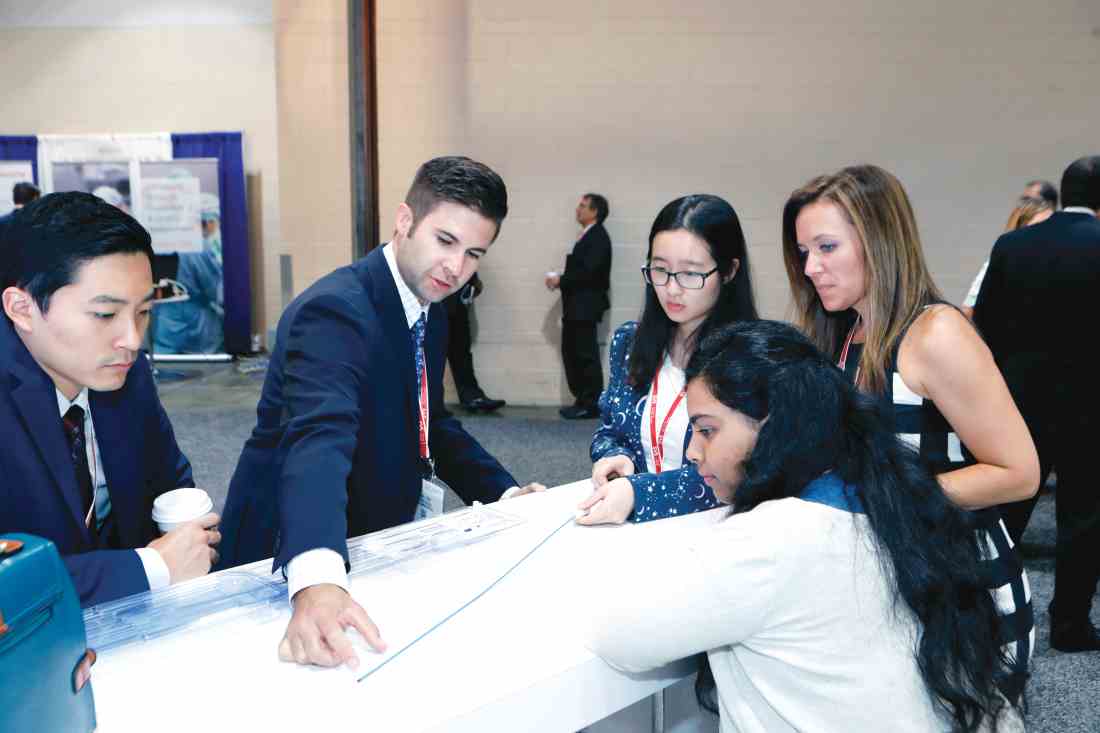
Input a keyword – such as “stents,” for example – and the website provides a listing of exhibitors who manufacture stents. Input “endovascular” and not only are companies listed but so are the Vascular and Endovascular Surgery Society and Vascular News/Charing Cross Symposium. Searches are possible for a specific vendor, as well, and can be refined.
This year’s Exhibit Hall also will include the Office Vascular Care Pavilion, of interest particularly for those clinicians who perform procedures in outpatient and office-based settings. Five vendors currently plan to exhibit at the pavilion, and four presentations for office-based providers are scheduled.
The Exhibit Hall on the lower level also hosts fun and games – literally. It’s the site for the Opening and Closing receptions, on Thursday and Friday evenings, respectively and the Scavenger Hunt. And attendees can also take advantage of non-CME learning opportunities, giveaways, training opportunities and networking potential.
The Opening Reception takes place from 5 to 6:30 p.m., coinciding with the Interactive Poster Session. The Closing Reception is from 4:30 to 5:30 p.m. Friday. It’s a great time to browse the exhibits, talk with vendors, meet up with friends and colleagues, sip on a beverage, and enjoy the food.
Participate in Scavenger Hunt
Games? That would be the Vascular Annual Meeting Scavenger Hunt, sure to be a hit with those with even a bit of a competitive streak. It’s simple and it’s fun. Just download the Mobile App to scan the QR codes found in sponsors’ booths throughout the Exhibit Hall. When a multiple-choice question appears on the display, answer it. Correct answers earn 10 points.
Vascular Live hosts innovative sessions about the latest products and development related to vascular surgery, in a theater-in-the-round setting during Thursday and Friday’s coffee breaks and lunch hours. These frequently are standing-room only, so be sure to arrive early for a good seat. (See the VAM Planner and the mobile app.)
The Exhibit Hall also is the place to be for coffee breaks, 10 a.m. and 3 p.m. Thursday and 9:30 a.m. and 3 p.m. Friday as well as lunch, at 12 p.m. Thursday and 12:15 p.m. Friday. Food stations offer box lunches – free to attendees, though tickets are required. And there are plenty of tables to permit sitting down and chatting with colleagues for a bit.
Industry participation in the VAM exhibits underwrites a significant portion of VAM, thereby allowing us to keep registration fees at a much lower rate than other industry meetings. Please support our industry partners. A complete list of exhibitors and their booth locations are found in the Connections on-site publication and in the Mobile App, VAM Planner and VAM website (vsweb.org/VAM19).
The Exhibit Hall is an integral part of the Vascular Annual Meeting. All members of the vascular team, as well as other attendees, will be able to see a wide-ranging array of products of interest to vascular surgeons and their teams from dozens of vendors.
The VAM website (vsweb.org/VAM19) and mobile app offer a listing of exhibitors. A real-time floor plan (vsweb.org/FloorMap) helps attendees navigate the Exhibit Hall to find the products they most want to see.
Input a keyword – such as “stents,” for example – and the website provides a listing of exhibitors who manufacture stents. Input “endovascular” and not only are companies listed but so are the Vascular and Endovascular Surgery Society and Vascular News/Charing Cross Symposium. Searches are possible for a specific vendor, as well, and can be refined.
This year’s Exhibit Hall also will include the Office Vascular Care Pavilion, of interest particularly for those clinicians who perform procedures in outpatient and office-based settings. Five vendors currently plan to exhibit at the pavilion, and four presentations for office-based providers are scheduled.
The Exhibit Hall on the lower level also hosts fun and games – literally. It’s the site for the Opening and Closing receptions, on Thursday and Friday evenings, respectively and the Scavenger Hunt. And attendees can also take advantage of non-CME learning opportunities, giveaways, training opportunities and networking potential.
The Opening Reception takes place from 5 to 6:30 p.m., coinciding with the Interactive Poster Session. The Closing Reception is from 4:30 to 5:30 p.m. Friday. It’s a great time to browse the exhibits, talk with vendors, meet up with friends and colleagues, sip on a beverage, and enjoy the food.
Participate in Scavenger Hunt
Games? That would be the Vascular Annual Meeting Scavenger Hunt, sure to be a hit with those with even a bit of a competitive streak. It’s simple and it’s fun. Just download the Mobile App to scan the QR codes found in sponsors’ booths throughout the Exhibit Hall. When a multiple-choice question appears on the display, answer it. Correct answers earn 10 points.
Vascular Live hosts innovative sessions about the latest products and development related to vascular surgery, in a theater-in-the-round setting during Thursday and Friday’s coffee breaks and lunch hours. These frequently are standing-room only, so be sure to arrive early for a good seat. (See the VAM Planner and the mobile app.)
The Exhibit Hall also is the place to be for coffee breaks, 10 a.m. and 3 p.m. Thursday and 9:30 a.m. and 3 p.m. Friday as well as lunch, at 12 p.m. Thursday and 12:15 p.m. Friday. Food stations offer box lunches – free to attendees, though tickets are required. And there are plenty of tables to permit sitting down and chatting with colleagues for a bit.
Industry participation in the VAM exhibits underwrites a significant portion of VAM, thereby allowing us to keep registration fees at a much lower rate than other industry meetings. Please support our industry partners. A complete list of exhibitors and their booth locations are found in the Connections on-site publication and in the Mobile App, VAM Planner and VAM website (vsweb.org/VAM19).
The Exhibit Hall is an integral part of the Vascular Annual Meeting. All members of the vascular team, as well as other attendees, will be able to see a wide-ranging array of products of interest to vascular surgeons and their teams from dozens of vendors.
The VAM website (vsweb.org/VAM19) and mobile app offer a listing of exhibitors. A real-time floor plan (vsweb.org/FloorMap) helps attendees navigate the Exhibit Hall to find the products they most want to see.
Input a keyword – such as “stents,” for example – and the website provides a listing of exhibitors who manufacture stents. Input “endovascular” and not only are companies listed but so are the Vascular and Endovascular Surgery Society and Vascular News/Charing Cross Symposium. Searches are possible for a specific vendor, as well, and can be refined.
This year’s Exhibit Hall also will include the Office Vascular Care Pavilion, of interest particularly for those clinicians who perform procedures in outpatient and office-based settings. Five vendors currently plan to exhibit at the pavilion, and four presentations for office-based providers are scheduled.
The Exhibit Hall on the lower level also hosts fun and games – literally. It’s the site for the Opening and Closing receptions, on Thursday and Friday evenings, respectively and the Scavenger Hunt. And attendees can also take advantage of non-CME learning opportunities, giveaways, training opportunities and networking potential.
The Opening Reception takes place from 5 to 6:30 p.m., coinciding with the Interactive Poster Session. The Closing Reception is from 4:30 to 5:30 p.m. Friday. It’s a great time to browse the exhibits, talk with vendors, meet up with friends and colleagues, sip on a beverage, and enjoy the food.
Participate in Scavenger Hunt
Games? That would be the Vascular Annual Meeting Scavenger Hunt, sure to be a hit with those with even a bit of a competitive streak. It’s simple and it’s fun. Just download the Mobile App to scan the QR codes found in sponsors’ booths throughout the Exhibit Hall. When a multiple-choice question appears on the display, answer it. Correct answers earn 10 points.
Vascular Live hosts innovative sessions about the latest products and development related to vascular surgery, in a theater-in-the-round setting during Thursday and Friday’s coffee breaks and lunch hours. These frequently are standing-room only, so be sure to arrive early for a good seat. (See the VAM Planner and the mobile app.)
The Exhibit Hall also is the place to be for coffee breaks, 10 a.m. and 3 p.m. Thursday and 9:30 a.m. and 3 p.m. Friday as well as lunch, at 12 p.m. Thursday and 12:15 p.m. Friday. Food stations offer box lunches – free to attendees, though tickets are required. And there are plenty of tables to permit sitting down and chatting with colleagues for a bit.
Industry participation in the VAM exhibits underwrites a significant portion of VAM, thereby allowing us to keep registration fees at a much lower rate than other industry meetings. Please support our industry partners. A complete list of exhibitors and their booth locations are found in the Connections on-site publication and in the Mobile App, VAM Planner and VAM website (vsweb.org/VAM19).
Focus on Office-Based Care
This year’s VAM features an exhibit pavilion, special Vascular Live presentations, and a breakfast session geared specifically to clinicians who work in office and outpatient settings.
The Office Vascular Care Pavilion is in Exhibit Hall B, on the lower level of the Gaylord National Resort & Convention Center, across from the SVS Booth. Office Vascular Care Live presentations (not eligible for CME credit) include:
Thursday, June 13
12:30 to 1 p.m. OBL 101; Krishna M. Jain, MD
3 to 3:30 p.m. OBL Chatter, industry presentations by Cordis®, A Cardinal Health company, Philips and Vein Care iGuide
Sessions include: Coming to a town near you! Life Cycle of an OBL, Factors Influencing Behavior of an OBL, and Industry Partnership, sponsored by Cordis®, A Cardinal Health company
Keys to Success and Methods of Failure in Today’s OBL, David Baker, sponsored by Philips
Friday, June 14
12:30 to 1 p.m. OBL Tips and Tools; R. Clement Darling III, MD
3 to 3:30 p.m. OBL Quality and Safety; Robert G. Molnar, MD
8:30 to 9:30 a.m. Ticket Required - The SVS also has a new member section focused on the move to outpatient and office-based settings, the Section on Outpatient and Office Vascular Care (SOOVC), which will hold its first meeting Friday in National Harbor 3. Tickets are available at Registration. Prospective members are welcome.
Saturday, June 15
6:30 to 8 a.m. Breakfast Session 9 will cover “Complications in Office-Based Procedures: Their Prevention and Management.” It is being presented in collaboration with the Outpatient Endovascular and Interventional Society.
This year’s VAM features an exhibit pavilion, special Vascular Live presentations, and a breakfast session geared specifically to clinicians who work in office and outpatient settings.
The Office Vascular Care Pavilion is in Exhibit Hall B, on the lower level of the Gaylord National Resort & Convention Center, across from the SVS Booth. Office Vascular Care Live presentations (not eligible for CME credit) include:
Thursday, June 13
12:30 to 1 p.m. OBL 101; Krishna M. Jain, MD
3 to 3:30 p.m. OBL Chatter, industry presentations by Cordis®, A Cardinal Health company, Philips and Vein Care iGuide
Sessions include: Coming to a town near you! Life Cycle of an OBL, Factors Influencing Behavior of an OBL, and Industry Partnership, sponsored by Cordis®, A Cardinal Health company
Keys to Success and Methods of Failure in Today’s OBL, David Baker, sponsored by Philips
Friday, June 14
12:30 to 1 p.m. OBL Tips and Tools; R. Clement Darling III, MD
3 to 3:30 p.m. OBL Quality and Safety; Robert G. Molnar, MD
8:30 to 9:30 a.m. Ticket Required - The SVS also has a new member section focused on the move to outpatient and office-based settings, the Section on Outpatient and Office Vascular Care (SOOVC), which will hold its first meeting Friday in National Harbor 3. Tickets are available at Registration. Prospective members are welcome.
Saturday, June 15
6:30 to 8 a.m. Breakfast Session 9 will cover “Complications in Office-Based Procedures: Their Prevention and Management.” It is being presented in collaboration with the Outpatient Endovascular and Interventional Society.
This year’s VAM features an exhibit pavilion, special Vascular Live presentations, and a breakfast session geared specifically to clinicians who work in office and outpatient settings.
The Office Vascular Care Pavilion is in Exhibit Hall B, on the lower level of the Gaylord National Resort & Convention Center, across from the SVS Booth. Office Vascular Care Live presentations (not eligible for CME credit) include:
Thursday, June 13
12:30 to 1 p.m. OBL 101; Krishna M. Jain, MD
3 to 3:30 p.m. OBL Chatter, industry presentations by Cordis®, A Cardinal Health company, Philips and Vein Care iGuide
Sessions include: Coming to a town near you! Life Cycle of an OBL, Factors Influencing Behavior of an OBL, and Industry Partnership, sponsored by Cordis®, A Cardinal Health company
Keys to Success and Methods of Failure in Today’s OBL, David Baker, sponsored by Philips
Friday, June 14
12:30 to 1 p.m. OBL Tips and Tools; R. Clement Darling III, MD
3 to 3:30 p.m. OBL Quality and Safety; Robert G. Molnar, MD
8:30 to 9:30 a.m. Ticket Required - The SVS also has a new member section focused on the move to outpatient and office-based settings, the Section on Outpatient and Office Vascular Care (SOOVC), which will hold its first meeting Friday in National Harbor 3. Tickets are available at Registration. Prospective members are welcome.
Saturday, June 15
6:30 to 8 a.m. Breakfast Session 9 will cover “Complications in Office-Based Procedures: Their Prevention and Management.” It is being presented in collaboration with the Outpatient Endovascular and Interventional Society.



